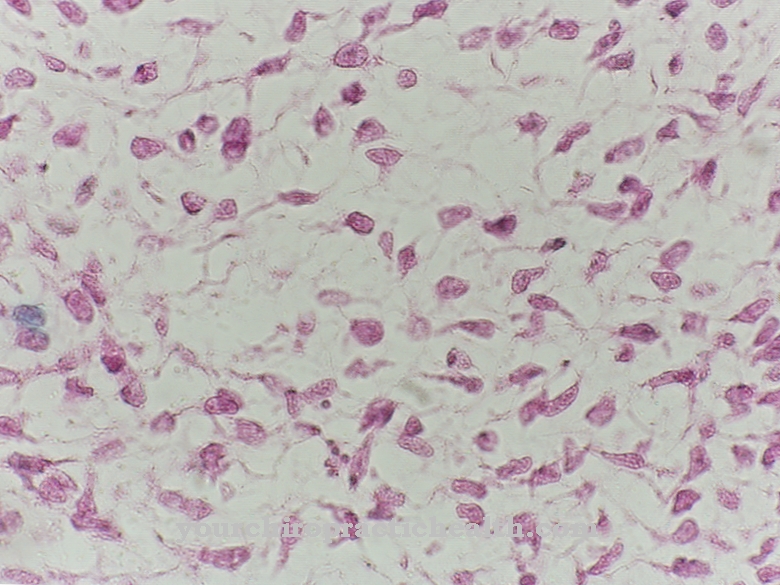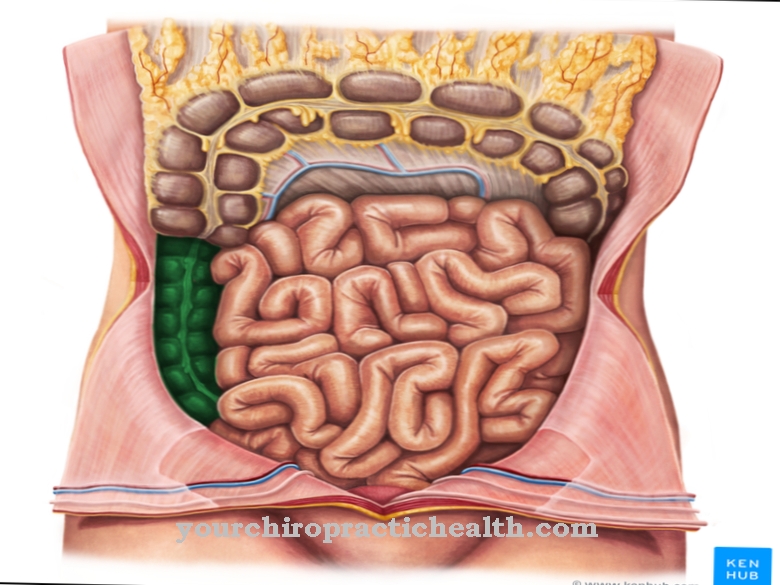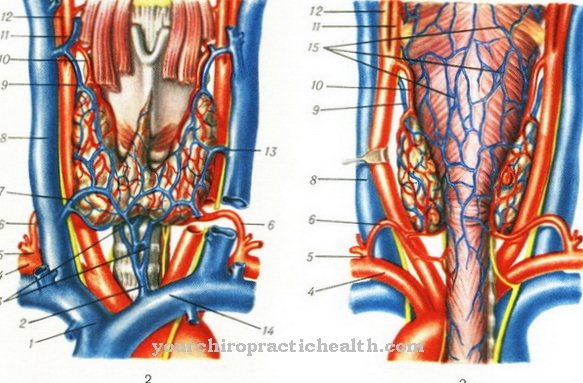Of the Thyrohyoid muscle belongs to the lower hyoid bone muscles (infrahyoid muscles) and is innervated by the ansa cervicalis. It is active when swallowing and thereby closes the larynx so that no food or liquid gets into the airways. Disorders of the thyrohyoid muscle can therefore lead to increased swallowing.
What is the thyrohyoid muscle?
The thyrohyoid muscle is a lower hyoid bone muscle (infrahyoid muscle) that occurs once in each half of the body.
The infrahyoid muscles also include the omohyoideus muscle, the sternohyoideus muscle, and the stylohyoid muscle. Their counterpart above the hyoid bone is represented by the suprahyoid muscles. Both groups have to contract in concert during the swallowing process. The common nerve supply through the ansa cervicalis contributes to the successful coordination.
The thyrohyoideus muscle owes its name to the fact that it creates a connection between the hyoid bone (os hyoideum) and thyroid cartilage. An outdated name for the thyroid cartilage of the larynx is "thyroid". Despite the naming, which is often misleading to laypeople, the thyrohyoid muscle is accordingly not connected to the thyroid gland (glandula thyroidea).
Anatomy & structure
The thyrohyoid muscle originates from the larynx, where it arises from the thyroid cartilage (cartilago thyroidea). In addition to the thyroid cartilage, the larynx has four other cartilage structures. Cartilago thyroidea is one of the larger of them and has an oblique notch, which anatomy calls the linea obliqua. It offers support to the muscle. The thyrohyoid muscle attaches to the hyoid bone (os hyoideum), where it is attached to the great horn (cornu majus).
The base of the thyrohyoid muscle is square. Its tissue consists of individual fibers that correspond to muscle cells. Thinner myofibrils, which are divided into sarcomeres, run through the elongated fibers. Each sarcomere is able to shorten itself. This process leads to contraction of the muscle over the length of the entire fiber. The neuronal innervation comes from the ansa cervicalis, which begins at the cervical plexus and represents a nerve loop in the neck. Its fibers come from the spinal nerves of the first to third cervical spinal cord segment (C1 – C3).
Function & tasks
During the swallowing process, the thyrohyoid muscle is responsible for protecting the windpipe (trachea) from the ingress of liquids and food. The act of swallowing consists of four roughly definable phases. In the oral preparation phase, the teeth grind up food and mix it with the saliva produced by the glands in the lining of the mouth and throat. The oral transport phase uses the tongue muscles to press the tongue against the roof of the mouth and to transport the food to the throat. The hyoglossus and styloglossus muscles are particularly active.
Then the palatal lifter and palatal tensioner move the soft palate upwards in order to close the access to the nose together with the Passavant's annular bulge. This step heralds the beginning of the pharyngeal transport phase in the swallowing process. The vocal folds (labia vocalia) and the epiglottis close, while the hyoid bone and the larynx are lifted. This process is also known as laryngeal elevation. The thyrohyoid muscle lifts the larynx and moves it proportionally closer to the hyoid bone. Together, the digastricus, mylohyoideus and stylohyoideus muscles also pull the hyoid bone upwards to support the upward movement. In this way, the thyrohyoid muscle and the other muscles involved prevent fluid or food from entering the windpipe (trachea).
To conclude the pharyngeal transport phase in the act of swallowing, the middle and lower pharyngeal constrictor (musculus constrictor pharyngis medius and musculus constrictor pharyngis inferior) push the food further back in the pharynx until it reaches the esophagus and there as part of the esophageal transport to 8 to 20 Seconds finally arrives in the stomach.
You can find your medication here
➔ Medicines against coughs and coldsDiseases
If the thyrohyoid muscle is unable to lift the larynx when swallowing and thus contribute to the closure of the windpipe, increased swallowing may occur. Liquid or solid substances penetrate the airways and trigger a cough reflex.
If this is not strong enough (or also disturbed), the substance can get into the lungs. Medicine calls this process foreign body aspiration. Due to the anatomical structure of the airways, foreign bodies find their way into the right bronchial tree more often, as the access is steeper than the path to the left bronchial tree. Penetrating food and fluids can damage the sensitive tissue of the respiratory system. They also carry the risk of causing infections. Doctors therefore usually use an endoscope to remove the foreign body. You insert the instrument through your mouth and airways.
Disorders of the thyrohyoid muscle often go hand in hand with other complaints, as the small muscles in the mouth and neck area are not only anatomically close together, but are also closely interconnected neuronally.The ansa cervicalis innervates the thyrohyoid muscle and the three other infrahyoid muscles - lesions on this nerve loop therefore affect the entire muscle group. If the nerve tract is already damaged before it exits the spinal cord, extensive paralysis can occur, depending on the extent of the damage, which affects all areas of the body below the injury. Spinal cord lesions arise, for example, from tumors, herniated discs and vertebral injuries.
Laryngeal cancer can also affect the thyrohyoid muscle. The mass either directly affects the muscle or hinders nerve fibers that innervate the infrahyoid muscle.
























.jpg)



